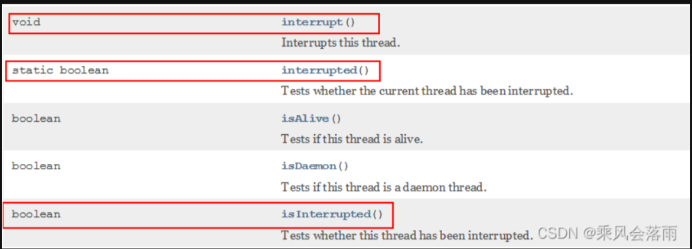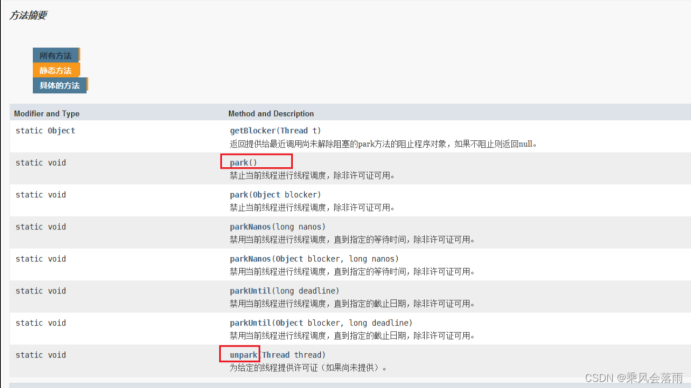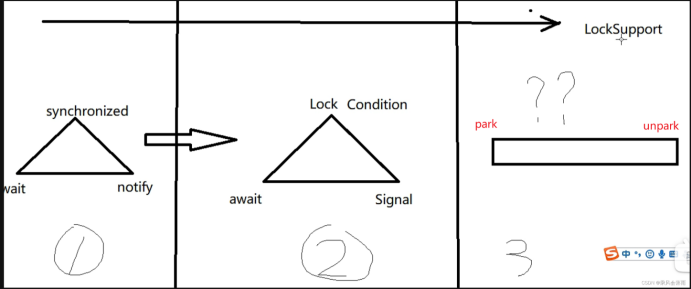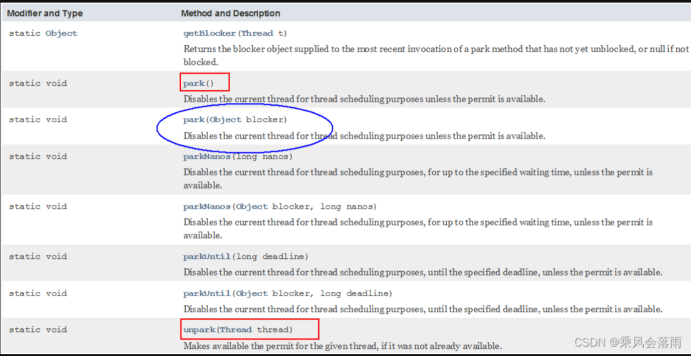(5)LockSupport与线程中断
LockSupport与线程中断
线程中断机制
阿里蚂蚁金服面试题

Void interrupt() 中断此线程
static boolean interrupted() 测试当前线程是否已被中断
boolean isInterrupted() 测试此线程是否已经被中断
三个方法了解过吗?用在哪?
如何停止一个运行中的线程?
如何中断一个运行中的线程??
什么是中断机制?
首先
一个线程不应该由其他线程来强制中断或停止,而是应该由线程自己自行停止。
所以,Thread.stop, Thread.suspend, Thread.resume 都已经被废弃了。
其次
在Java中没有办法立即停止一条线程,然而停止线程却显得尤为重要,如取消一个耗时操作。
因此,Java提供了一种用于停止线程的协商机制——中断。
中断只是一种协作协商机制,Java没有给中断增加任何语法,中断的过程完全需要程序员自己实现。
若要中断一个线程,你需要手动调用该线程的interrupt方法,该方法也仅仅是将线程对象的中断标识设成true;
接着你需要自己写代码不断地检测当前线程的标识位,如果为true,表示别的线程要求这条线程中断,
此时究竟该做什么需要你自己写代码实现。
每个线程对象中都有一个标识,用于表示线程是否被中断;该标识位为true表示中断,为false表示未中断;
通过调用线程对象的interrupt方法将该线程的标识位设为true;可以在别的线程中调用,也可以在自己的线程中调用。
eg.顾客在无烟餐厅中吸烟,服务员希望他别吸烟了,不是强行停止他吸烟,而是给他的标志位打为true,具体的停止吸烟还是要顾客自己停止。(体现了协商机制)
中断的相关API方法之三大方法说明

public void interrupt() 实例方法,实例方法interrupt()仅仅是设置线程的中断状态为true,发起一个协商而不会立刻停止线程
public static boolean interrupted() 静态方法,Thread.interrupted();判断线程是否被中断,并清除当前中断状态这个方法做了两件事:1 返回当前线程的中断状态2 将当前线程的中断状态设为false(这个方法有点不好理解,因为连续调用两次的结果可能不一样。)
public boolean isInterrupted() 实例方法,判断当前线程是否被中断(通过检查中断标志位)
大厂面试题:如何使用中断标识停止线程?
1如何停止中断运行中的线程?
① 通过一个volatile变量实现
volatile保证了可见性,t2修改了标志位后能马上被t1看到
public class interruptDemo { static volatile boolean isStop = false; public static void main(String[] args) { new Thread(()->{ while(true){ if(isStop){//如果这个标志位被其他线程改为true了 System.out.println(Thread.currentThread().getName()+"\t isStop被修改为true,程序终止"); break; } System.out.println("t1 ------hello volatile");//----------------------如果没停止,那就一直打印 } },"t1").start(); try {TimeUnit.MILLISECONDS.sleep(20);} catch (InterruptedException e) {e.printStackTrace();} new Thread(()->{ isStop = true; },"t2").start(); } } //-- //t1 ------hello volatile //t1 ------hello volatile //t1 ------hello volatile //t1 ------hello volatile //t1 ------hello volatile //t1 ------hello volatile //t1 ------hello volatile //t1 isStop被修改为true,程序终止
② 通过AtomicBoolean(原子布尔型) public class interruptDemo { static AtomicBoolean atomicBoolean = new AtomicBoolean(false); public static void main(String[] args) { m1_volatile(); } public static void m1_volatile() { new Thread(()->{ while(true){ if(atomicBoolean.get()){//如果这个标志位被其他线程改为true了 System.out.println(Thread.currentThread().getName()+"\t isStop被修改为true,程序终止"); break; } System.out.println("t1 ------hello volatile");//----------------------如果没停止,那就一直打印 } },"t1").start(); try {TimeUnit.MILLISECONDS.sleep(20);} catch (InterruptedException e) {e.printStackTrace();} new Thread(()->{ atomicBoolean.set(true); },"t2").start(); } } //t1 ------hello volatile //t1 ------hello volatile //t1 ------hello volatile //t1 ------hello volatile //t1 ------hello volatile //t1 ------hello volatile //t1 isStop被修改为true,程序终止
③ 通过Thread类自带的中断api方法实现 //默认的中断标志位是false,然后被改为了true public static void main(String[] args) { m1_volatile(); } public static void m1_volatile() { Thread t1 = new Thread(() -> { while (true) { if (Thread.currentThread().isInterrupted()) {//一旦发现中断标志位被修改 System.out.println(Thread.currentThread().getName() + "\t isInterrupted()被修改为true,程序终止"); break; } System.out.println("t1 ------hello interrupt ");//----------------------如果没停止,那就一直打印 } }, "t1"); t1.start(); try {TimeUnit.MILLISECONDS.sleep(20);} catch (InterruptedException e) {e.printStackTrace();} new Thread(()->{ t1.interrupt();//把t1中断 },"t2").start(); } } //t1 ------hello interrupt //t1 ------hello interrupt //t1 ------hello interrupt //t1 ------hello interrupt //t1 ------hello interrupt //t1 ------hello interrupt //t1 ------hello interrupt //t1 ------hello interrupt //t1 ------hello interrupt //t1 isInterrupted()被修改为true,程序终止
—API源码分析
实例方法interrupt(),没有返回值
//Thread.java public void interrupt() { if (this != Thread.currentThread()) checkAccess(); synchronized (blockerLock) { Interruptible b = blocker; if (b != null) { interrupt0(); // Just to set the interrupt flag----调用了interrupt0()方法 b.interrupt(this); return; } } interrupt0(); } //Thread.java /* Some private helper methods */ private native void setPriority0(int newPriority); private native void stop0(Object o); private native void suspend0(); private native void resume0(); private native void interrupt0(); //---------------------------调用了c底层 private native void setNativeName(String name); 实例方法isInterrupted,返回布尔值 //Thread.java public boolean isInterrupted() { return isInterrupted(false); } //Thread.java private native boolean isInterrupted(boolean ClearInterrupted);//也调用了c底层
说明
具体来说,当对一个线程,调用 interrupt() 时:
如果线程处于正常活动状态,那么会将该线程的中断标志设置为 true,仅此而已。被设置中断标志的线程将继续正常运行,不受影响。所以, interrupt() 并不能真正的中断线程,需要被调用的线程自己进行配合才行。
② 如果线程处于被阻塞状态(例如处于sleep, wait, join 等状态),在别的线程中调用当前线程对象的interrupt方法,那么线程将立即退出被阻塞状态(中断状态将被清除),并抛出一个InterruptedException异常。
(中断不活动的线程不会产生任何影响,看下面案例)
2 当前线程的中断标识为true,是不是线程就立刻停止?
否
仅仅设置了一个中断状态
看看中断是否会立即停止这个300的线程
否,虽然中断标志位变了。但是i一直在循环
public class InterruptDemo02 { public static void main(String[] args) { Thread t1 = new Thread(()->{ for(int i = 0;i < 300;i ++){ System.out.println("---------" + i); } System.out.println("after t1.interrupt()---第2次----"+Thread.currentThread().isInterrupted()); },"t1"); t1.start(); System.out.println("before t1.interrupt()----"+t1.isInterrupted()); t1.interrupt(); try {TimeUnit.MILLISECONDS.sleep(3);} catch (InterruptedException e) {e.printStackTrace();} System.out.println("after t1.interrupt()---第1次---"+t1.isInterrupted()); try {TimeUnit.MILLISECONDS.sleep(3000);} catch (InterruptedException e) {e.printStackTrace();} System.out.println("after t1.interrupt()---第3次---"+t1.isInterrupted()); } } //before t1.interrupt()----false //---------0 //---------1 //---------2 //---------3 //.... //---------136 //after t1.interrupt()---第1次---true ------此处中断标志位设置为了true,但是t1仍然在运行 //---------137 //---------298 //---------299 //after t1.interrupt()---第2次----true //after t1.interrupt()---第3次---false//中断不活动的线程不会产生任何影响,线程结束后应该是自动变为了false
在我们基本中断程序的骨架上 + 一个sleep阻塞
中断异常 且 会导致程序无限循环
public class InterruptDemo03 { public static void main(String[] args) { Thread t1 = new Thread(()->{ while(true){ if(Thread.currentThread().isInterrupted()){ System.out.println(Thread.currentThread().getName()+"\t"+ "中断标志位:"+Thread.currentThread().isInterrupted()+"程序终止"); break; } try { Thread.sleep(200); } catch (InterruptedException e) { e.printStackTrace(); // Thread.currentThread().interrupt(); 假如加了这个,程序可以终止,只会爆异常 } System.out.println("-----hello InterruptDemo03"); } },"t1"); t1.start(); try {TimeUnit.MILLISECONDS.sleep(1);} catch (InterruptedException e) {e.printStackTrace();} new Thread(() -> t1.interrupt()).start(); } } //爆异常了,并且程序一直在跑 //java.lang.InterruptedException: sleep interrupted // at java.lang.Thread.sleep(Native Method) //-----hello InterruptDemo03 //-----hello InterruptDemo03 //-----hello InterruptDemo03 //...... //---------------------------- //---------加了Thread.currentThread().interrupt(); //java.lang.InterruptedException: sleep interrupted // at java.lang.Thread.sleep(Native Method) // at com.zhang.admin.controller.InterruptDemo03.lambda$main$0(InterruptDemo03.java:15) // at java.lang.Thread.run(Thread.java:748) //-----hello InterruptDemo03 //t1 中断标志位:true程序终止
② 如果线程处于被阻塞状态(例如处于sleep, wait, join 等状态),在别的线程中调用当前线程对象的interrupt方法,那么线程将立即退出被阻塞状态(中断状态将被清除),并抛出一个InterruptedException异常。
/**
* 1 中断标志位 默认是false
* 2 t2 ----->t1发出了中断协商,t2调用t1.interrupt(),中断标志位true
* 3 中断标志位true,正常情况下,程序停止,^-^
* 4 中断标志位true,异常情况下,InterruptedException,将会把中断状态清除,并且将收到InterruptedException。中断标志位false导致无限循环。
*
* 5 在catch块中,需要再次给中断标志位设置为true,2次调用停止
*/
sleep方法抛出InterruptedException后,中断标识也被清空置为false,我们在catch没有通过th.interrupt()方法再次将中断标志设置为true,这就导致无限循环了
小总结
中断只是一种协同机制,修改中断标识位仅此而已,而不是立刻stop打断
3 静态方法Thread.interrupted(),谈谈你的理解
api里的第二个
public static boolean interrupted()
静态方法,Thread.interrupted();判断线程是否被中断,并清除当前中断状态这个方法做了两件事:1 返回当前线程的中断状态2 将当前线程的中断状态设为false(这个方法有点不好理解,因为连续调用两次的结果可能不一样。)
public class InterruptDemo04 { public static void main(String[] args) { System.out.println(Thread.currentThread().getName()+"\t"+Thread.interrupted()); System.out.println(Thread.currentThread().getName()+"\t"+Thread.interrupted()); System.out.println("-----1"); Thread.currentThread().interrupt();//中断标志位设置为true System.out.println("-----2"); System.out.println(Thread.currentThread().getName()+"\t"+Thread.interrupted()); System.out.println(Thread.currentThread().getName()+"\t"+Thread.interrupted()); } } //main false //main false //-----1 //-----2 //main true //main false 看下源码,interrupted()对比isInterrupted() public static boolean interrupted() { return currentThread().isInterrupted(true); } private native boolean isInterrupted(boolean ClearInterrupted); public boolean isInterrupted() { return isInterrupted(false); } private native boolean isInterrupted(boolean ClearInterrupted);
他们在底层都调用了native方法isInterrupted。
只不过传入参数ClearInterrupted一个传参传了true,一个传了false。
静态方法interrupted() 中true表示清空当前中断状态。
实例方法isInterrupted 则不会。
LockSupport是什么
官方解释:用于创建锁和其他同步类的基本线程阻塞原语。
核心就是park()和unpark()方法
park()方法是阻塞线程
unpark()方法是解除阻塞线程

线程等待唤醒机制
3种让线程等待和唤醒的方法
使用Object中的wait()方法让线程等待,使用Object中的notify()方法唤醒线程
使用JUC包中Condition的await()方法让线程等待,使用signal()方法唤醒线程
LockSupport类可以阻塞当前线程以及唤醒指定被阻塞的线程

①Object类中的wait和notify方法实现线程等待和唤醒
正常
public class LockSupportDemo { public static void main(String[] args) { Object objectLock = new Object(); new Thread(() -> { synchronized (objectLock) { System.out.println(Thread.currentThread().getName()+"\t ---- come in"); try { objectLock.wait();//----------------------这里先让他等待 } catch (InterruptedException e) { e.printStackTrace(); } } System.out.println(Thread.currentThread().getName()+"\t"+"---被唤醒了"); },"t1").start(); //暂停几秒钟线程 try { TimeUnit.SECONDS.sleep(3L); } catch (InterruptedException e) { e.printStackTrace(); } new Thread(() -> { synchronized (objectLock) { objectLock.notify();//-------------------------再唤醒它 System.out.println(Thread.currentThread().getName()+"\t ---发出通知"); } },"t2").start(); } } //t1 ---- come in //t2 ---发出通知 //t1 ---被唤醒了 异常1—去掉synchronized 说明要使用wait和notify必须加synchronized
public class LockSupportDemo { public static void main(String[] args) { Object objectLock = new Object(); new Thread(() -> { // synchronized (objectLock) { System.out.println(Thread.currentThread().getName()+"\t ---- come in"); try { objectLock.wait(); } catch (InterruptedException e) { e.printStackTrace(); } // } System.out.println(Thread.currentThread().getName()+"\t"+"---被唤醒了"); },"t1").start(); //暂停几秒钟线程 try { TimeUnit.SECONDS.sleep(3L); } catch (InterruptedException e) { e.printStackTrace(); } new Thread(() -> { // synchronized (objectLock) { objectLock.notify(); System.out.println(Thread.currentThread().getName()+"\t ---发出通知"); // } },"t2").start(); } } //t1 ---- come in //Exception in thread "t1" java.lang.IllegalMonitorStateException // at java.lang.Object.wait(Native Method) // at java.lang.Object.wait(Object.java:502) // at com.zhang.admin.controller.LockSupportDemo.lambda$main$0(LockSupportDemo.java:15) // at java.lang.Thread.run(Thread.java:748)
异常2—把notify和wait的执行顺序对换
说明顺序不能对换
public class LockSupportDemo { public static void main(String[] args) { Object objectLock = new Object(); new Thread(() -> { try { TimeUnit.SECONDS.sleep(1); } catch (InterruptedException e) { e.printStackTrace(); } synchronized (objectLock) { System.out.println(Thread.currentThread().getName()+"\t ---- come in"); try { objectLock.wait(); } catch (InterruptedException e) { e.printStackTrace(); } } System.out.println(Thread.currentThread().getName()+"\t"+"---被唤醒了"); },"t1").start(); new Thread(() -> { synchronized (objectLock) { objectLock.notify();//这个先执行了 System.out.println(Thread.currentThread().getName()+"\t ---发出通知"); } },"t2").start(); } } //一直处于循环中
小总结
wait和notify方法必须要在同步块或者方法里面,且成对出现使用
先wait后notify才OK,顺序
②Condition接口中的await后signal方法实现线程的等待和唤醒
正常
public class LockSupportDemo { public static void main(String[] args) { Lock lock = new ReentrantLock(); Condition condition = lock.newCondition(); new Thread(() -> { lock.lock(); try { System.out.println(Thread.currentThread().getName()+"\t-----come in"); condition.await(); System.out.println(Thread.currentThread().getName()+"\t -----被唤醒"); } catch (InterruptedException e) { e.printStackTrace(); } finally { lock.unlock(); } },"t1").start(); //暂停几秒钟线程 try { TimeUnit.SECONDS.sleep(1); } catch (InterruptedException e) { e.printStackTrace(); } new Thread(() -> { lock.lock(); try { condition.signal(); } catch (Exception e) { e.printStackTrace(); } finally { lock.unlock(); } System.out.println(Thread.currentThread().getName()+"\t"+"我要进行唤醒"); },"t2").start(); } } //t1 -----come in //t2 我要进行唤醒 //t1 -----被唤醒
异常1原理同上
仍然返回IllegalMonitorStateException
异常2 原理同上
仍然在不停的循环
小总结
await和notify类似于上面wait和notify
Condition中的线程等待和唤醒方法,需要先获取锁
一定要先await后signal,不能反了
Object和Condition使用的限制条件
总结
线程先要获得并持有锁,必须在锁块(synchronized或lock)中
必须要先等待后唤醒,线程才能够被唤醒
③LockSupport类中的park等待和unpark唤醒
是什么
通过park()和unpark(thread)方法来实现阻塞和唤醒线程的操作
LockSupport是用来创建锁和其他同步类的基本线程阻塞原语。
LockSupport类使用了一种名为Permit(许可) 的概念来做到阻塞和唤醒线程的功能, 每个线程都有一个许可(permit),
permit(许可)只有两个值1和0,默认是0。0 是阻塞,1是唤醒
可以把许可看成是一种(0,1)信号量(Semaphore),但与 Semaphore 不同的是,许可的累加上限是1。
许可(Permit)
主要方法
API

阻塞
park()/park(Object blocker)
调用LockSupport.park()时,发现它调用了unsafe类,并且默认传了一个0
public static void park() {
UNSAFE.park(false, 0L);
}
permit默认是零,所以一开始调用park()方法,当前线程就会阻塞,直到别的线程将当前线程的permit设置为1时,park方法会被唤醒,
然后会将permit再次设置为零并返回。
唤醒
调用LockSupport.unpark();时,也调用了unsafe类
public static void unpark(Thread thread) {
if (thread != null)
UNSAFE.unpark(thread);
}
调用unpark(thread)方法后,就会将thread线程的许可permit设置成1(注意多次调用unpark方法,不会累加,permit值还是1)会自动唤醒thread线程,即之前阻塞中的LockSupport.park()方法会立即返回。
代码
正常+无锁块要求
public class LockSupportDemo { public static void main(String[] args) { Thread t1 = new Thread(()->{ System.out.println(Thread.currentThread().getName()+"\t----------come in"); LockSupport.park(); System.out.println(Thread.currentThread().getName()+"\t----------被唤醒了"); },"t1"); t1.start(); new Thread(()->{ LockSupport.unpark(t1); System.out.println(Thread.currentThread().getName()+"\t-----发出通知,去唤醒t1"); },"t2").start(); } } //t1 ----------come in //t2 -----发出通知,去唤醒t1 //t1 ----------被唤醒了
之前错误的先唤醒后等待,LockSupport照样支持
public class LockSupportDemo { public static void main(String[] args) { Thread t1 = new Thread(()->{ try {TimeUnit.SECONDS.sleep(3);} catch (InterruptedException e) {e.printStackTrace();} System.out.println(Thread.currentThread().getName()+"\t----------come in"+"\t"+System.currentTimeMillis()); LockSupport.park(); System.out.println(Thread.currentThread().getName()+"\t----------被唤醒了"+"\t"+System.currentTimeMillis()); },"t1"); t1.start(); new Thread(()->{ LockSupport.unpark(t1); System.out.println(Thread.currentThread().getName()+"\t-----发出通知,去唤醒t1"); },"t2").start(); } } //t2 -----发出通知,去唤醒t1 //t1 ----------come in 1654750785663 //t1 ----------被唤醒了 1654750785663
sleep方法3秒后醒来,执行park无效,没有阻塞效果,解释如下。先执行了unpark(t1)导致上面的park方法形同虚设无效,时间是一样的
- 类似于高速公路的ETC,提前买好了通行证unpark,到闸机处直接抬起栏杆放行了,没有park拦截了。
成双成对要牢记
最后
许可证是只要一个的
public class LockSupportDemo { public static void main(String[] args) { Thread t1 = new Thread(()->{ try {TimeUnit.SECONDS.sleep(3);} catch (InterruptedException e) {e.printStackTrace();} System.out.println(Thread.currentThread().getName()+"\t----------come in"+"\t"+System.currentTimeMillis()); LockSupport.park(); LockSupport.park(); System.out.println(Thread.currentThread().getName()+"\t----------被唤醒了"+"\t"+System.currentTimeMillis()); },"t1"); t1.start(); new Thread(()->{ LockSupport.unpark(t1); LockSupport.unpark(t1); System.out.println(Thread.currentThread().getName()+"\t-----发出通知,去唤醒t1"); },"t2").start(); } } //t2 -----发出通知,去唤醒t1 //t1 ----------come in 1654750970677--------------------卡在这里了
小总结
Lock Support是用来创建锁和其他同步类的基本线程阻塞原语。
Lock Support是一个线程阻塞工具类, 所有的方法都是静态方法, 可以让线程在任意位置阻塞, 阻塞之后也有对应的唤醒方法。归根结
底, Lock Support调用的Unsafe中的native代码。
Lock Support提供park() 和unpark() 方法实现阻塞线程和解除线程阻塞的过程
Lock Support和每个使用它的线程都有一个许可(permit) 关联。
每个线程都有一个相关的permit, permit最多只有一个, 重复调用un park也不会积累凭证。
形象的理解
线程阻塞需要消耗凭证(permit) , 这个凭证最多只有1个。
当调用方法时
*如果有凭证,则会直接消耗掉这个凭证然后正常退出;
*如果无凭证,就必须阻塞等待凭证可用;
而****则相反, 它会增加一个凭证, 但凭证最多只能有1个, 累加无效。
面试题
为什么可以突破wait/notify的原有调用顺序?
因为un park获得了一个凭证, 之后再调用park方法, 就可以名正言顺的凭证消费, 故不会阻塞。
先发放了凭证后续可以畅通无阻。
为什么唤醒两次后阻塞两次,但最终结果还会阻塞线程?
因为凭证的数量最多为1, 连续调用两次un park和调用一次un park效果一样, 只会增加一个凭证;
而调用两次park却需要消费两个凭证, 证不够, 不能放行。




 浙公网安备 33010602011771号
浙公网安备 33010602011771号